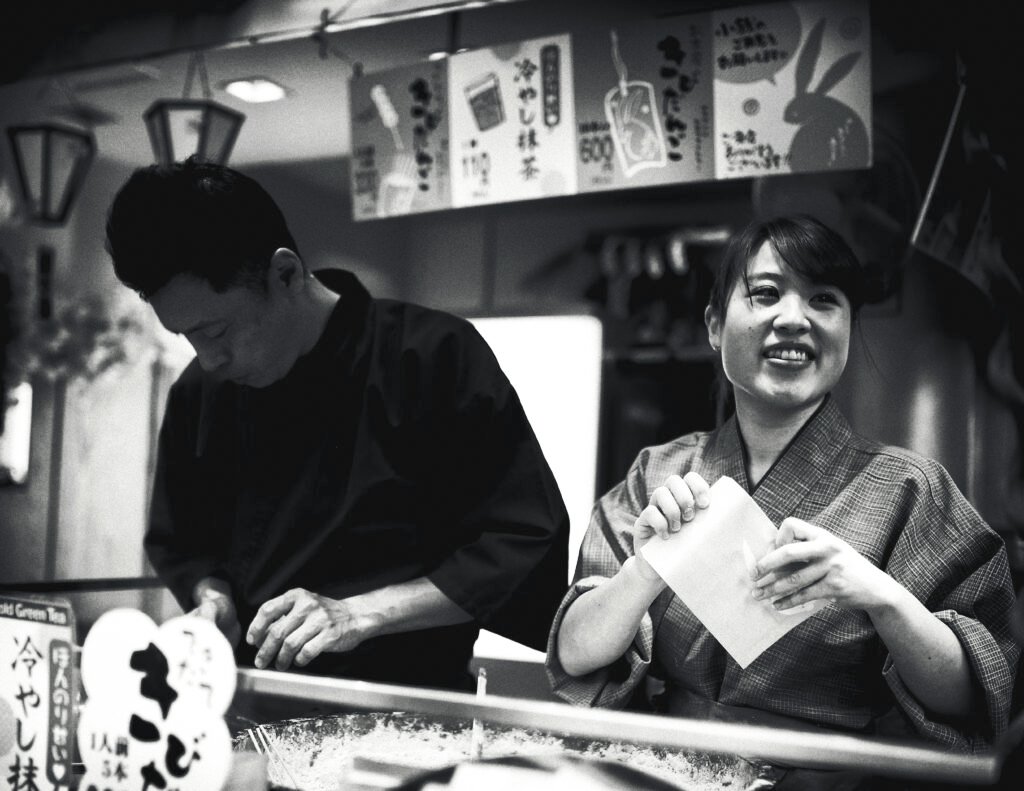
Just beyond the thunder gate—Kaminarimon—where tourists funnel into the soul of Asakusa like coins dropped into a shrine box, there’s a narrow lane veering left. Past the postcard stands, past the incense-scented souvenirs, you’ll hear it: a cheerful shout over the sizzle of batter and heat.
“Irasshaimaseeee! Takoyaki! Piping hot and full of love!”
That’s Nao, twenty-five, standing behind her modest market stall, her hair tied in a pony tail, cheeks dusted pink from the fire and her own constant grinning. Her eyes crinkle when she laughs—wide, warm, and unfiltered. She works the iron takoyaki griddle like she’s playing drums: rhythmic, joyful, precise.
She ladles batter, adds fat chunks of octopus, green onion, pickled ginger, tempura scraps—then flips the balls with practiced flicks of bamboo picks, golden and spinning like a magic trick.
“I call that one the samurai flip,” she jokes to a group of giggling teens snapping photos.
*“This one? Sumo wrestler—it never wants to turn over!”
She laughs at her own joke, spraying sauce in elegant lines, showering each tray with fluttering katsuobushi that dances with the heat. Her stall near Kaminarimon-dori is wrapped in bold red banners, the characters for たこ焼き drawn by her grandfather—who once sold oden on this very street. A tiny Bluetooth speaker hums vintage J-pop, and hanging from one corner is a lucky cat that waves endlessly to the crowd.
Nao didn’t grow up thinking she’d be a street vendor. She studied early childhood education, dreamed of becoming a kindergarten teacher. But after graduation, her mother fell ill, and she came home to help with the family stall. She planned to stay a few months. That was three years ago.
“I thought I’d be shaping young minds,” she says, flipping a tray of six sizzling takoyaki balls.
“But I guess shaping perfect octopus balls counts too, right?”
Tourists line up. Locals, too. Even rickshaw pullers stop by between rides. Everyone gets the same treatment—an extra smile, a playful nudge, maybe a bonus ball if it’s the end of the batch.
At the heart of Asakusa, where ancient meets neon and prayers blend with commerce, Nao’s stall is something else—something warm, human, rooted. The takoyaki is good, yes. Crisp outside, gooey inside, octopus soft like the sea. But it’s her laughter that lingers, like the scent of bonito and batter that clings to your coat. Before she closes up, she scribbles a message on a chalkboard for the next day:
“Tomorrow’s secret topping: yuzu-mayo love!” With a doodle of a winking octopus.
The lanterns above flicker on. The crowds thin. But somewhere near Kaminarimon, a young woman hums softly, wipes down her griddle, and whispers to the hot iron: “See you tomorrow, old friend.”
Takoyaki vendors in Asakusa are an integral part of the district’s vibrant street food culture. They offer a unique culinary experience that combines skillful preparation, engaging customer interaction, and a sensory delight. For both locals and tourists, enjoying takoyaki in Asakusa is a memorable experience that reflects the rich culinary heritage and dynamic atmosphere of Tokyo’s historic heart. Whether as a quick snack or part of a broader exploration of the area, takoyaki provides a delicious and authentic taste of Japan.